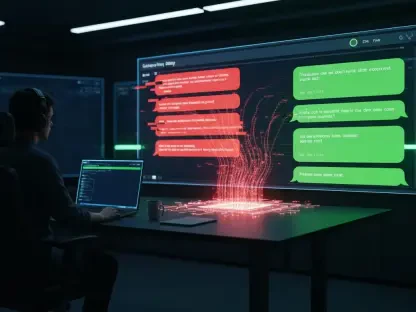Imagine a critical gateway to a corporate network, designed to protect sensitive data, becoming the very entry point for a devastating cyberattack. This scenario is unfolding for numerous organizations worldwide as the Akira ransomware group exploits a persistent vulnerability in SonicWall SSLVPN systems. This issue, tied to an improper access control flaw in various SonicWall firewall appliances, has emerged as a significant threat, with attacks escalating since August of this year. The importance of addressing such vulnerabilities cannot be overstated, as they jeopardize the security of entire networks and the data they safeguard.
The purpose of this FAQ is to provide clear, actionable insights into this pressing cybersecurity challenge. It aims to answer key questions about the nature of the vulnerability, the tactics employed by attackers, and the steps organizations can take to protect themselves. Readers can expect to gain a comprehensive understanding of the threat landscape surrounding SonicWall SSLVPN flaws and learn practical measures to mitigate risks associated with ransomware campaigns.
This content will delve into specific aspects of the Akira group’s methods, the reasons behind the ongoing exposure of many systems, and expert recommendations for defense. By breaking down complex technical issues into accessible explanations, the goal is to equip businesses and IT professionals with the knowledge needed to fortify their defenses against such sophisticated threats.
Key Questions or Key Topics
What Is the SonicWall SSLVPN Vulnerability Exploited by Akira Ransomware?
The SonicWall SSLVPN vulnerability at the heart of these attacks is an improper access control flaw affecting Gen5, Gen6, and Gen7 firewall appliances. This issue allows unauthorized users to bypass security measures and gain access to restricted resources. Its significance lies in the widespread use of SonicWall products by organizations globally, making it a prime target for ransomware groups seeking to infiltrate corporate networks.
Despite a patch being available for over a year, a surprising number of systems remain unupdated, leaving them exposed to exploitation. Security researchers have noted a sharp increase in attacks leveraging this flaw since earlier this year, highlighting the urgency of addressing outdated software. The failure to apply updates often stems from resource constraints, lack of awareness, or complex IT environments that delay patch management.
This vulnerability serves as a stark reminder of the risks associated with neglecting timely security updates. Reports from cybersecurity experts indicate that unpatched systems are often the first point of entry for attackers, emphasizing the need for diligent maintenance of edge devices like firewalls. Organizations ignoring this flaw risk severe consequences, including data breaches and financial losses due to ransomware demands.
How Does Akira Ransomware Exploit This Vulnerability?
Akira ransomware operators employ a multi-pronged approach to exploit the SonicWall SSLVPN flaw, showcasing a high level of sophistication in their attack methods. Beyond targeting the access control vulnerability, they capitalize on default LDAP group configurations that inadvertently allow unauthorized access to network resources. This misconfiguration, often overlooked by administrators, provides an additional pathway for infiltration.
Another tactic involves abusing the Virtual Office Portal, a SonicWall service that, in certain default settings, permits public access. Attackers use previously compromised credentials to configure multi-factor authentication (MFA) or time-based one-time passwords (TOTP), further securing their foothold within the system. This combination of exploiting unpatched systems and leveraging misconfigured settings amplifies the effectiveness of their campaigns.
Evidence from security investigations reveals that Akira has honed these techniques over at least two years, focusing on edge devices as critical entry points. Their strategy underscores a broader trend in ransomware attacks, where attackers meticulously identify and exploit multiple weaknesses. This persistent and calculated approach makes it imperative for organizations to address not just one, but all potential security gaps in their infrastructure.
Why Are So Many Organizations Still Vulnerable to This Threat?
A significant factor contributing to the ongoing vulnerability of many organizations is the failure to apply available patches for the SonicWall SSLVPN flaw. Despite the patch’s release over a year ago, numerous businesses have yet to update their systems, often due to operational challenges or insufficient prioritization of cybersecurity measures. This delay creates a dangerous window of opportunity for attackers.
Additionally, misconfigured settings, such as default LDAP groups and publicly accessible portals, compound the risk. Many IT teams may not fully understand the implications of these configurations or lack the resources to regularly audit their systems. As a result, even organizations with some security measures in place can remain exposed to sophisticated threats like Akira ransomware.
Security experts have repeatedly stressed that the combination of unpatched systems and configuration errors represents a systemic issue in cybersecurity practices. The growing complexity of IT environments, coupled with a shortage of skilled personnel, often hinders timely remediation. This situation serves as a critical lesson on the need for proactive security policies and regular system assessments to prevent exploitation by determined adversaries.
What Steps Can Organizations Take to Mitigate These Risks?
To counter the threat posed by Akira ransomware and similar attacks, organizations must adopt a comprehensive set of defensive measures. A fundamental step is to apply the latest patches to SonicWall firewall appliances without delay, as this directly addresses the initial entry point exploited by attackers. Ensuring that systems are up to date is a non-negotiable aspect of maintaining network security.
Beyond patching, rotating passwords for all SonicWall accounts and enforcing robust MFA policies are essential practices. Restricting access to the Virtual Office Portal to trusted or internal networks can significantly reduce the attack surface. Additionally, continuous monitoring for unauthorized access attempts can help detect and respond to potential breaches before they escalate.
Cybersecurity recommendations also emphasize the importance of regular audits to identify and correct misconfigurations, such as default LDAP settings. By fostering a culture of vigilance and allocating resources toward ongoing training for IT staff, businesses can better prepare for evolving threats. These actionable steps, supported by expert consensus, provide a strong foundation for safeguarding critical infrastructure against ransomware campaigns.
Summary or Recap
This FAQ highlights the critical cybersecurity threat posed by the Akira ransomware group through their exploitation of a SonicWall SSLVPN vulnerability. Key points include the nature of the improper access control flaw affecting multiple firewall appliances, the sophisticated multi-pronged tactics used by attackers, and the persistent issue of unpatched systems combined with configuration errors. Each aspect underscores the severity of the risk to organizations that fail to address these weaknesses.
The main takeaways revolve around the urgent need for timely updates, proper configuration of security settings, and robust defensive measures like password rotation and MFA enforcement. These insights aim to guide businesses in reducing their exposure to ransomware threats targeting edge devices. The discussion also reflects a broader concern within the industry about the dangers of neglecting fundamental security practices.
For those seeking deeper exploration, additional resources on ransomware prevention and SonicWall-specific security advisories are recommended. Engaging with cybersecurity communities and staying informed about emerging threats can further enhance preparedness. This summary encapsulates the essential elements of the threat landscape and the consensus on effective mitigation strategies.
Conclusion or Final Thoughts
Reflecting on the persistent challenge of Akira ransomware exploiting SonicWall SSLVPN flaws, it becomes evident that the cybersecurity landscape demands constant vigilance and swift action. The escalation of attacks earlier this year served as a wake-up call for many organizations, revealing the high cost of delayed updates and overlooked configurations. This situation underscores a pivotal lesson: proactive defense is not just an option but a necessity.
Moving forward, businesses need to prioritize the implementation of recommended safeguards, such as patching systems and enforcing strict access controls, to prevent similar incidents. Exploring partnerships with cybersecurity experts or investing in automated monitoring tools can offer additional layers of protection. These steps represent a commitment to resilience in the face of evolving threats.
Ultimately, the impact of such ransomware campaigns prompts a broader reflection on how organizations approach the security of critical infrastructure. Considering the potential consequences of a breach, it is crucial to evaluate existing policies and adapt to emerging risks. Taking these lessons to heart can transform vulnerabilities into opportunities for strengthening defenses against future cyber threats.









